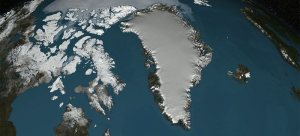The Greenland ice sheet is likely to be more resistant to global warming than previously thought, finds a new study published in the scientific journal Nature.

An international team of scientists shows that even if critical temperature thresholds are temporarily crossed by up to 6.5 degrees Celsius until 2100, a possible tipping of the ice sheet and therefore drastic sea level rise over hundreds of thousands of years could be prevented.
To achieve this, measures to reduce greenhouse gases would have to be taken as quickly as possible following the critical rise in temperature, so that the temperature can be stabilised at no more than 1.5 degree Celsius above pre-industrial levels in the long term.
“We investigated how the Greenland ice sheet might react over centuries to millennia to the drastic and rapid, yet so far still comparably short-lived warming of our time,” explains lead author Nils Bochow from UiT The Arctic University of Norway, and the Potsdam Institute for Climate Impact Research (PIK).
“We found that the ice sheet reacts so slowly to human-made warming that reversing the current warming trend by cutting greenhouse gas emissions within centuries may prevent it from tipping. Yet, also just temporarily overshooting the temperature thresholds can still lead to a peak in sea level rise of more than a metre in our simulations,” adds co-author Niklas Boers from PIK and the Technical University of Munich, Germany.
The calculations indicate that even if the global mean temperatures peaked at about 6.5 degrees Celcius above pre-industrial levels by 2100 (the so called “overshoot”), a subsequent cooling within a few centuries could prevent a complete collapse of the ice sheet and consecutive sea level rise.
“Our results underline that even if we do not manage to stay below 1.5 or 2 degrees of global warming within the coming decades, and temporarily cross the critical temperature threshold of the Greenland ice sheet, we still have a chance to act,” says Nils Bochow.
Nevertheless, the authors explicitly emphasise that the slow reaction of the ice sheet does not imply that humanity should slow down in their endeavours to combat climate change.
Greenland ice sheet safe under 1.7 degrees warming, but other climate elements react faster
The team of scientists conducted a range of simulations with two independent ice sheet models. In each model run, global mean temperatures rose to up to 6.5 degrees above pre-industrial levels until the year 2100. After this, temperatures were gradually reduced over different time ranges, from 100 to 10.000 years.
According to the scientists, such a cooling imitates a possible restoration of the climate system by applying different carbon-removal scenarios, for example large-scale reforestation or carbon capture and storage technologies. The experiments identified a number of steps, determined by threshold temperatures, where the ice sheet will tip and eventually collapse completely within tens to hundreds of thousands of years, if global warming is not reversed.
Additionally, the results confirm previous study results about the long-term critical temperature threshold between 1.7 and 2.3 degrees Celcius of global mean temperature for a near-complete melting of the Greenland ice sheet over hundreds or thousands of years, potentially leading to a global sea-level rise of more than seven meters. 1,7 degrees of global warming could be a safe limit, under which the Greenland ice sheet would not tip according to the employed models.
The authors caution, however, that their results are based on a limited set of runs of two ice sheet models that disregard how the concerted global climate change influences the Arctic climate apart from temperatures and precipitation.
According to the researchers, essentially all other sub-elements of the climate system react faster to global warming than an ice sheet. These include rainforests, wind and precipitation patterns, or ocean current systems, which all change or even commit to abrupt, irreversible changes on significantly shorter time scales, leading to much shorter windows of opportunity to avoid tipping.
“And even when avoiding a large-scale tipping of the Greenland ice sheet, temporary sea-level rise can be substantial. The higher temperatures rise, the more difficult it will be to bring them down to safe levels in the long term. This is why we need to act fast and keep global mean temperatures below 1.5 degrees Celsius,” concludes Niklas Boers. “The Greenland ice sheet is just a small part of the picture and there are many other negative consequences related to human made climate change that we might face if we don’t act in time.”
